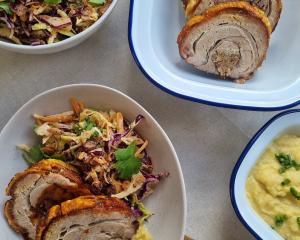
Gluten-free food writer Becky Excell will never forget her first gluten-free Christmas... mainly because she felt miserable and missed out on eating almost everything worth eating!
Leaving the dramatics aside, back then, she was just happy to survive the day without gluten gate-crashing the party.
But now, she has realised that Christmas doesn’t have to mean missing out on a single thing, and the same applies to you - here is one recipe to help, a classic Christmas cake.
For Excell, who describes herself as a professional procrastinator, the only hard part is ensuring you make this as early as possible.
“That’ll give this beauty ample time to mature and develop, guaranteeing an intense flavour that only comes from feeding across weeks and months. I promise it’s worth the wait!”
Have a Merry (gluten-free) Christmas!

MAKES 20 SLICES
Takes 4¾ hours + 12 hours soaking
For the soaked fruit
(The total weight of your mixed dried fruit should be 850g. I use the following, but use what you have to hand/is available.)
350g currants
150g sultanas (golden raisins)
125g raisins
125g glace cherries
50g candied mixed peel
50g dried cranberries
120ml (½ cup) Amaretto or brandy, plus extra for ‘feeding’
Grated zest of 2 lemons, and the juice of 1
For the cake
225g (1 cup plus 2 tbsp) dark brown sugar
225g (1 cup) butter, softened, plus extra for greasing
4 large eggs
1 tbsp black treacle (molasses)
1½ tsp ground mixed spice
225g (1¾ cups) gluten-free plain (all-purpose) flour
½ tsp xanthan gum
25g (¼ cup) ground almonds (almond flour)
50g blanched almonds, chopped
To finish
5 tbsp apricot jam
400g marzipan
700g white fondant icing Icing (confectioners’) sugar, for dusting
Red and green fondant icing, for a holly decoration
Method

Preheat your oven to 120degC fan / 140degC. Grease a 20cm loose-bottomed, deep, round cake tin (pan) and line the base with non-stick baking parchment. Then line the sides, ensuring the parchment is slightly taller than the tin itself.
Finally, wrap a double layer of baking parchment around the outside of the tin and secure round the middle with string, with the parchment about 5cm taller than the top of the tin. (This prevents the sides of the cake from burning during the long bake.)
Add all the cake ingredients to a large mixing bowl. Mix until fully combined, ideally with an electric hand whisk. Gradually stir in all your soaked, dried fruit thoroughly, using a spatula or wooden spoon. Spoon into your prepared tin, making sure it’s all nice and level.
Cover the top of your cake with a square of baking parchment with a hole in the middle of it - the hole helps with steam and the covering helps prevent the cake from burning. Bake in the oven for around 4 hours - it will be a dark golden colour and fairly firm. Allow the cake to fully cool in the tin.
Once cooled, poke all over with a skewer (until about halfway down) and spoon over a little extra Amaretto or brandy. Remove the cake from the tin and wrap in two layers of baking parchment followed by two layers of kitchen foil.
Store in an airtight container for up to 3 months, feeding the cake every few weeks by pouring over a tablespoon of Amaretto or brandy.
A week before serving, remove the cake from its baking parchment/foil wrapping and turn it upside down so that its flat end is facing upwards. Spread all over with a thin layer of slightly warmed apricot jam.
Generously dust your work surface with icing sugar and briefly knead your marzipan until softer and more workable. Dust your surface once again and your rolling pin too. Roll out your marzipan to a large circle, around 4mm thick, ensuring it’s big enough to cover the entire cake. Use your rolling pin to lift up the marzipan and cover your cake with it.
Carefully press it onto the top and down the sides so that it’s lovely and smooth. Trim any excess marzipan around the base, using a sharp knife.
Dust your surface once more with icing sugar, then roll out your white fondant icing to a large circle, around 4mm thick. Again, use your rolling pin to lift up the icing and cover the cake with it. Trim off any excess.
Decorate the cake however you wish with edible or non-edible decorations, such as ribbons or festive figures. I used a little red and green fondant to make holly leaves and berries, using a little water to stick them in place.












